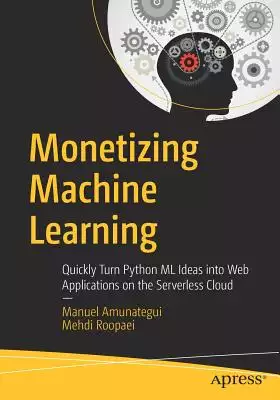pythonanywhere flask的問題,透過圖書和論文來找解法和答案更準確安心。 我們挖掘到下列精選懶人包
pythonanywhere flask的問題,我們搜遍了碩博士論文和台灣出版的書籍,推薦Van Winkel, Alex寫的 Create a Python based website in less than 20 minutes: Using the power of pythonanywhere and Flask to create a basic website for 和Amunategui, Manuel/ Roopaei, Mehdi的 Monetizing Machine Learning: Quickly Turn Python Ml Ideas into Web Applications on the Serverless Cloud都 可以從中找到所需的評價。
這兩本書分別來自 和所出版 。
亞洲大學 資訊工程學系 朱學亭所指導 許龍哲的 以計程車大數據為基礎之載客熱點預測平台之建置 (2020),提出pythonanywhere flask關鍵因素是什麼,來自於載客熱點預測、深度學習、地圖視覺化。
除了pythonanywhere flask,大家也想知道這些:
Create a Python based website in less than 20 minutes: Using the power of pythonanywhere and Flask to create a basic website for

為了解決pythonanywhere flask 的問題,作者Van Winkel, Alex 這樣論述:
以計程車大數據為基礎之載客熱點預測平台之建置
為了解決pythonanywhere flask 的問題,作者許龍哲 這樣論述:
智慧交通為現代城市的重要課題,而載客熱點預測是智慧交通的議題之一。成功地預測出未來時間點乘客搭車的熱點可以使計程車公司更容易的調度車輛、減少郊區車輛較少的問題,有效率的調派車輛能使載客次數增加從而提高獲利。本論文利用計程車行車紀錄的資料結合深度學習與地圖視覺化的方式建置載客熱點預測平台,使用開源的地圖工具(Folium)進行地圖之繪製,將神經網路模型預測出的結果與地圖結合,使數據能夠在地圖上以熱點的方式呈現。地圖視覺化的原因是希望使用者能夠容易的使用透過深度學習所產生的結果,以熱點圖的方式在網站地圖呈現讓使用者只需要打開地圖就能看出當前及未來之載客趨勢,進而讓計程車司機前往乘車熱點區域服務,
亦或是讓計程車公司調派車輛前往指定地點。本論文目標為有效解決計程車空車、郊區車輛較少之問題,並且平台建構方向希望使用者能夠簡易的操作,僅需要稍微熟悉就能輕鬆使用。
Monetizing Machine Learning: Quickly Turn Python Ml Ideas into Web Applications on the Serverless Cloud

為了解決pythonanywhere flask 的問題,作者Amunategui, Manuel/ Roopaei, Mehdi 這樣論述:
Take your Python machine learning ideas and create serverless web applications accessible by anyone with an Internet connection. Some of the most popular serverless cloud providers are covered in this book--Amazon, Microsoft, Google, and PythonAnywhere. You will work through a series of common Pytho
n data science problems in an increasing order of complexity. The practical projects presented in this book are simple, clear, and can be used as templates to jump-start many other types of projects. You will learn to create a web application around numerical or categorical predictions, understand t
he analysis of text, create powerful and interactive presentations, serve restricted access to data, and leverage web plugins to accept credit card payments and donations. You will get your projects into the hands of the world in no time.Each chapter follows three steps: modeling the right way, desi
gning and developing a local web application, and deploying onto a popular and reliable serverless cloud provider. You can easily jump to or skip particular topics in the book. You also will have access to Jupyter notebooks and code repositories for complete versions of the code covered in the book.
What You'll LearnExtend your machine learning models using simple techniques to create compelling and interactive web dashboardsLeverage the Flask web framework for rapid prototyping of your Python models and ideasCreate dynamic content powered by regression coefficients, logistic regressions, gradi
ent boosting machines, Bayesian classifications, and moreHarness the power of TensorFlow by exporting saved models into web applicationsCreate rich web dashboards to handle complex real-time user input with JavaScript and Ajax to yield interactive and tailored contentCreate dashboards with paywalls
to offer subscription-based accessAccess API data such as Google Maps, OpenWeather, etc.Apply different approaches to make sense of text data and return customized intelligenceBuild an intuitive and useful recommendation site to add value to users and entice them to keep coming backUtilize the freem
ium offerings of Google Analytics and analyze the resultsTake your ideas all the way to your customer's plate using the top serverless cloud providersWho This Book Is ForThose with some programming experience with Python, code editing, and access to an interpreter in working order. The book is geare
d toward entrepreneurs who want to get their ideas onto the web without breaking the bank, small companies without an IT staff, students wanting exposure and training, and for all data science professionals ready to take things to the next level. Manuel Amunategui has decades of professional exper
ience in programming, data science, and creating end-to-end solutions for customers in various industries. He sees informational and educational gaps in the industry. He has been fortunate to work with software at Microsoft, in finance on Wall Street, in research at one of the largest health systems
in the US, and now as VP of Data Science at SpringML, a Google Cloud and Salesforce preferred partner. He understands what it takes to start new careers and new businesses. Since 2013, he has been advocating for data science through blogs, vlogs, and educational material. He has grown and curated v
arious highly focused and niche social media channels, including a YouTube channel with 60 videos and 350k views and a very popular applied data science blog. His teaching perspective is about welcoming any new comer with a desire to learn, creating material to quickly overcome learning curves, and
demonstrating through clear narrative and practical examples that it is never as hard as most people think.Mehdi Roopaei, PhD, is a postdoctoral fellow at Open Cloud Institute of University of Texas at San Antonio, with a research focus on data-driven decision-making systems. He has 12 years of expe
rience in teaching at the university level, more than 980 citations for peer-reviewed publications, and two published books. His focus is on cloud machine learning, data analytics, and the AI-Thinking platform (proposed at HICSS51).